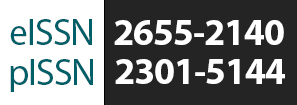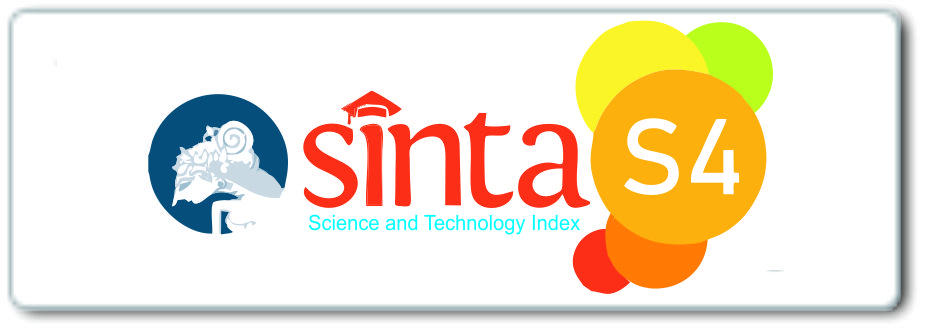PENGARUH TINGKAT USABILITY DESAIN RESPONSIF WEB MOBILE PERGURUAN TINGGI TERHADAP PERSEPSI PENGGUNA
DOI:
https://doi.org/10.33375/vslt.v7i1.1080Keywords:
Responsif, Website, Mobile, Usability, VisualAbstract
Desain web responsif merupakan pendekatan yang menunjukkan desain dan pengembangan yang harus merespon perilaku pengguna dan lingkungan berdasarkan ukuran layar, platform, dan orientasi. Desain responsif yang diterapkan pada web perguruan tinggi ingin memberikan kemudahan dalam berinteraksi. Untuk mengukur bagaimana sebuah web dapat efektif, efisien dan membuat pengguna puas saat berinteraksi digunakan teori usability. Selain itu aspek kognitif juga dapat mempengaruhi proses penyampaian informasi melalui web. Penelitian ini bertujuan untuk mengidentifikasi pengaruh tingkat usability desain responsif web mobile perguruan tinggi terhadap persepsi pengguna. Objek penelitiannya adalah lima web mobile perguruan tinggi yaitu Universitas Indonesia, Institut Teknologi Bandung, Universitas Sebelas Maret, Universitas Padjajaran, dan Universitas Pendidikan Indonesia. Analisis secara kuantitatif terhadap tingkat usability kelima web mobile menunjukkan bahwa tingkat usability yang dimiliki oleh sebuah web mobile perguruan tinggi mempengaruhi tampilan visual web berdasarkan persepsi penggunanya. Tingkat usability memberikan pengaruh sebesar 67,1%Â terhadap persepsi pengguna melalui tampilan visual.
Downloads
References
Bloomer, C. (1976): Principles of visual perception, New York: Van Nostrand Reinhold Company.
Gapinski, D., & Runyon, E. (2012): Responsive design in higher education. mStoner. http://youtu.be/qGPwkDtQrxU, diakses pada tanggal 2 Desember 2013 pukul 16.36 WIB.
Gaunt, M. (2014): Navigation and action patterns https://developers.google.com/web/fundamentals/layouts/navigation-patterns/?hl=en, diakses pada tanggal 12 Februari 2015 pukul 10.27 WIB.
Joly, K. (2012): One Design to rull them all? Responsive web design in higher education. University Business, 15(2), 49.
Keynote. (2012): 2012 Mobile user survey. http://www.slideshare.net/keynote_systems/keynote-mobile-user-survey-1-h2012, diakses pada tanggal 9 Februari 2015 09.29 WIB.
Marcotte, E. (2011): Responsive Web Design. New York: A Book Apart.
Media Queries. (2011): Choicesresponse http://mediaqueri.es/cho/, diakses pada tanggal 4 Maret 2015 pukul 10.43 WIB.
Nielsen, J. (1999): Designing Web Usability. Barkeley: New Riders.
Nielsen, J, Loranger, Hoa. (2006): Prioritizing Web Usability. Barkeley: New Riders.
Seward, Dan. (2011): Designing Usable Mobile Websites. Brisbane: Peak Usability.
Sugiyono. (2013): Metode Penelitian Kombinasi (Mixed Methods). Bandung: Alfabeta.
Ware, C. (2004): Information Visualization: Perception For Design. MA: Morgan Kaufmann.
Wearesocial. (2015): Digital, Social & Mobile in 2015
http://wearesocial.net/blog/2015/01/digital-social-mobile-worldwide-2015/, diakses pada tanggal 5 Februari 2015 pukul 09.32 WIB.
Wroblewski, L. (2011): Mobile First. New York: A Book Apart.
Wroblewski, L. (2012): Multi-Device layout pattern
http://www.lukew.com/ff/entry.asp?1514, diakses pada tanggal 3 Februari 2015 pukul 19.50 WIB.
____, http://webometrics.info.
____, www.4icu.org.
____, www.topuniversities.com.
____, semantic differential
http://psychology.ucdavis.edu/faculty_sites/sommerb/sommerdemo/scaling/semdiff.htm.
Downloads
Published
Issue
Section
License
Authors who publish with Visualita agree to the following terms:
- Authors retain copyright and grant the journal right of first publication with the work simultaneously licensed under a Creative Commons Attribution-NonCommercial 4.0 International License.
- Authors are able to enter into separate, additional contractual arrangements for the non-exclusive public distribution and display of the journal's published version of the work (e.g., post it to an institutional repository or publish it in a book), with an acknowledgement of its initial publication in this journal.
- Authors wishing to include items (such as images or other media, or any creative works of others whether previously published or not) must contact the original copyright holder to obtain explicit permission to publish these items in Visualital. Writing permission should include: the title(s) of any copyrighted work, original place of publication if applicable, and an acknowledgement of having read Visualita copyright notice. Authors are responsible for obtaining this permission and keeping it in their own records for later verification.





